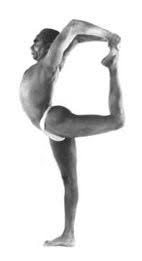Dive into Dancer Pose
Oh, Dancer Pose. It’s kind of the quintessential yoga posture. It’s a balancing backbend that requires focus, flexibility, and strength. The great thing about Dancer, or Lord of the Dance Pose, is that there’s so many variations that can be explored. Below there’s Sri BKS Iyengar holding his foot with his hands. And then there’s me. It’s clear that I’ve lost some range of motion since I’ve started weight training, but I have no issues using a strap to help me out.
Standing Backbend
Although there’s different ways of exploring Dancer Pose, the posture is a standing backbend. The spine is in extension and, with his grand range of motion, Iyengar is able to hold his foot with his hands to create a continued circular energy. (Please note that the ability to hold your foot will not extend the length of your life, give you special powers, or make you a better person so we can all set aside our obsession with holding the foot.)
I might like to deemphasize the holding of the foot, however the image shows the backbending nature of the shape. In some bodies, the backbend is less defined. The posture is almost like a version of Warrior III with a foot grab. Often this occurs when there’s more effort on dropping the chest and less emphasis on the lift of the back leg. Think you’re in this boat? Then I’ve got the perfect variation for you!
Unsatisfying Dancer Pose
I think the name says it all. This version of Dancer Pose is not exactly enjoyable, but it is effective. To set this one up enter the posture just as you would set up your traditional Dancer Pose. Reach your arm back and bend your knee back on the same side. Rather than holding onto to the foot as you typically would, simply touch the pads of your fingers to the inside of your heel. While maintaining that very light connection begin to enter the posture. The key is that you have to kick and use the glutes and hamstrings of your lifted leg. With this unsatisfying version you take your grip out of the equation and you’re forced to work really hard!
I’ve been teaching this version for a few years now and the responses vary from, “I really did not like that Dancer Pose thing you made us do” to “That was awesome! Can we do that again?” You truly cannot please everyone.
Although the approach is not loved by all, everyone can agree that it is effective and limits the initial reaction to drop the chest in order to enter the posture.
Deepen Your Dancer
Are you looking to explore other variations of your Dancer Pose? Perhaps you feel like you’ve hit a rut and not sure where to go next? Here’s a few postures and exercises that might help you explore other aspects of Dancer:
Do more backside strengthening - Unsatisfying Dancer Pose is a great example, but there’s plenty of ways for you activate the muscles around your spine, glutes, and hamstrings in postures like Locust and Bridge Variations.
Lengthen your midsection - Many of us, myself included, do so much to strengthen the abdominals and we often ignore that the abdominals need to be lengthened too. Don’t let Dancer Pose be the first time you lengthen your frontside in a practice. Warm up with postures like Supported Fish, Sphinx, and lunge variations.
Open your shoulders - If you are on the quest to hold your foot be patient with the process. Holding onto your foot and hoping for the best is not a sustainable approach. Often the limitation is in the shoulder joints when the arms are in an overhead position. Take the time to open your shoulders and lats with things like Archer Arms, variations on Puppy Pose, and Side Bends.
As always, every yoga posture will be unique and individual based on the student. Don’t let the images on social media make you feel like your version of Dancer Pose is less than. Embrace what you bring to the practice and give yourself permission to explore further when you’re ready.



